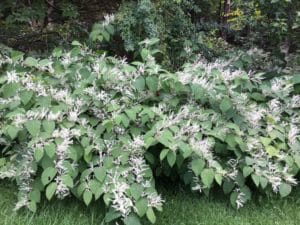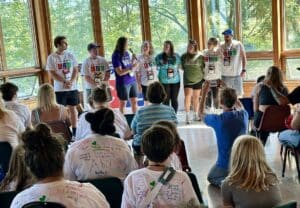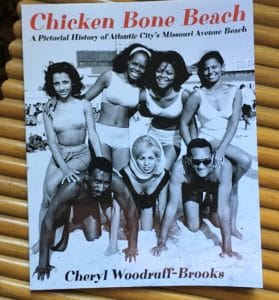Hello, fellow lover of all things green,
As you may know there’s a podcast version of our weekly chats from the screen porch. Last week, I recorded the episode on 9-11 (link below). The sky was bright blue and the air crisp— much like that day our world changed. The anniversary of the tragedy reminds me of when I registered for a fiction workshop at Warren County Community College. The desk person at the library, also a student, handed me the paperwork for a student ID date-stamped 9-11, bringing a reflection of that day and the wisdom to remember, learn, grow, and love.
“Do you recall that day?” I asked the young man.
“No, other than people crying.” He revealed he was four at the time.
We chatted about how it brought a wave of patriotism and acceptance of each other, no matter our cultural differences.
“It’s sad that much of the comradery is lost today.” He nodded in agreement, such a kind young man of mixed descent.
I look forward to the day we look upon each other as One. One with nature. One with the world. Maybe it sounds cliché. Perhaps it’s wishful thinking. I think of it as Hope.
What does this have to do with gardening or nature? The garden of life?

Orange Jewel Weed (Impatiens capensis)
Two beautiful plants draw attention along the road in September. There’s Orange Jewelweed, also known as Spotted Jewelweed. Impatiens capensis is an annual plant native to North America that thrives along streams, creeks, and in trenches roadside. They grow three to five feet tall and have almost see-through succulent-like stems. The flower’s shape reminds me of foxgloves, though they dance on the tips rather than ride all along the stems. Hummingbirds, butterflies, and other insects adore the nectar.
Then there’s Knotweed (Fallopia japonica) an invasive plant from Asia. Yet, the showy, lacey white flowers covering the colonizing plants are magnets for pollinators when not much else is blooming. Beekeepers make the best use of the invader by cutting the hollow stems and bundling them as a habitat for solitary tunnel-nesting native bees.
Let us not forget our roots.

Knotweed (Fallopia japonica)
Perhaps it’s a far-reaching wish that plants that found their way here from other countries become integrated into our environment as the balance of nature adapts. Maybe their “invasive” status can become no longer so, as hopefully, wildlife learns to use the imported plant for sustenance so that native plants are no longer squelched. Maybe a dream, but let’s not forget our roots; for most of us, we are imports, too.
A few years ago, I had the joy of meeting Cheryl Woodruff-Brooks at an event hosted by Hippocampus Magazine. Cheryl authored Chicken Bone Beach, A Pictorial History of Atlantic City’s Missouri Avenue Beach. She came upon the idea when she marveled over a photo exhibit from the Chicken Bone Beach Collection by a self-taught photographer.
Joy, Community, and Love
In her book, Cheryl explained, ‘While so many images of the publicly accepted African American history have shown struggle, pain, humiliation, and dismay, John W. Mosley’s photographs depicted joy, laughter, family, fun, community, and love.’
During our chat, she asked what I do for a living.
“Get out. You make a living designing garden?” Cheryl whips out her phone and scrolls for photos. “I love to garden.”
She shared the creative layout of her plot in a community garden, explaining how she plants something new each year. One year, she had sunflowers in the middle of the garden, which the birds loved.
“I gave you the seeds; the least you can do is not poop on my vegetables,” she joked. “So, this year, I didn’t put the sunflowers in the middle and tried beets.”
Gardening like life is evolutionary. May we always remember the past, learn and grow from it, and do so with love.
Garden Dilemmas? AskMaryStone@gmail.com and your favorite Podcast App.
Enjoy more of the story in the Garden Dilemmas Podcast (12 soothing minutes):
Link to more about Jewelweed and Knotweed in September Roadside Beauties

Comfort Zone Campers Become Volunteers

Comfort Zone Camp– September 13-15, 2024
Celebrating 25 Years
Comfort Zone Camp (CZC), a bereavement camp for kids and young adults, grew after 9-11. The founder, Lynne Hughes, of the Virginia-based camp, knew she had to offer camps in the NY Tri-State area. Now in its 25th year, Comfort Zone Camp provides weekend camps free for families in 12 states nationwide, serving over 24,000 campers.
One-third of the campers become volunteers, pictured here at the recent Loss by Overdose Camp held in Fishkill, New York, in partnership with A Little Hope Foundation. Others then become staff members, such as Krista Collopy, Senior Regional Director (in purple)— helping to change lives.
Volunteering doesn’t have to be in the form of an organization. We all can make a difference by volunteering to care for our land and each other. To Remember, Learn, Grow, and Love.




